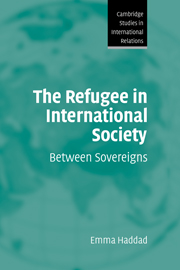Book contents
- Frontmatter
- Contents
- Preface
- 1 The refugee ‘problem’
- PART I The refugee: a conceptual analysis
- PART II The refugee: an historical analysis
- 5 The inter-war perspective
- 6 Refugees and international protection in the Cold War era
- PART III The refugee: a contemporary analysis
- Select Bibliography
- Index
- CAMBRIDGE STUDIES IN INTERNATIONAL RELATIONS
5 - The inter-war perspective
Published online by Cambridge University Press: 22 September 2009
- Frontmatter
- Contents
- Preface
- 1 The refugee ‘problem’
- PART I The refugee: a conceptual analysis
- PART II The refugee: an historical analysis
- 5 The inter-war perspective
- 6 Refugees and international protection in the Cold War era
- PART III The refugee: a contemporary analysis
- Select Bibliography
- Index
- CAMBRIDGE STUDIES IN INTERNATIONAL RELATIONS
Summary
It became a common experience for a refugee to find himself on a frontier, trapped between a country that had spat him out and a country that would not let him in.
Dorothy ThompsonSeveral events between the end of the nineteenth and beginning of the twentieth centuries led to the creation of refugees hitherto unknown. When pogroms were unleashed against Jews in Tsarist Russia in 1880, millions fled in search of refuge. The wars in the Balkans of 1912–13 caused the displacement of millions more as did, of course, the First World War. By 1926 the refugee population in Europe was estimated at 9.5 million, while more than twenty million individuals were displaced within states. International society had never had to deal with a mass refugee ‘problem’ prior to this period, and the way the international community responded to the ethical dilemma posed by the emergence of the modern refugee was based on underlying normative assumptions about both international society and, by extension, the individuals within it. Experiments in regimenting the phenomenon led to a formalised regime.
This chapter discusses the specific way the refugee developed as a concept in international society in the inter-war period and how the international community dealt with her. It first looks at the construction of the refugee in relation to particular understandings of sovereignty prevailing at the time. Next it analyses what this meant in terms of defining the refugee and establishing her as an individual of specific international concern.
- Type
- Chapter
- Information
- The Refugee in International SocietyBetween Sovereigns, pp. 99 - 127Publisher: Cambridge University PressPrint publication year: 2008

